Fagots
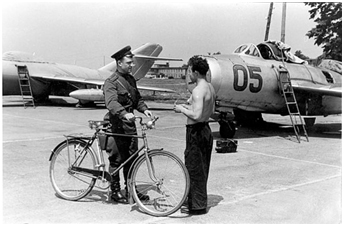
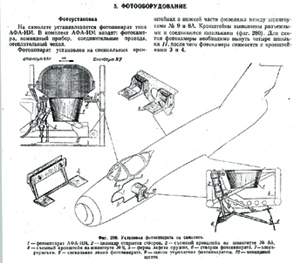 Although the MiG-15 "Fagot" fighters were initially equipped with an AFA-IM camera as standard (> Link), it was nevertheless a real fighter, revealed during the Korean War. However, a directive of the Council of Ministers of April 1950 instructed Mikoyan's OKB-155 to develop a reconnaissance variant of the MiG-15
carrying an AFA-BA/40 camera (> Link 1 / > Link 2).
The aircraft chosen for this modification was a MiG-15bis, which was given the designation SR (Samolet Razvedchik - Reconnaissance Aircraft). The camera was mounted between the guns, between frames n°8a and 9, in the same place as the AFA-IM of the MiG-15. The MiG-15 and MiG-15bis "Fagot-B" had a similar armament with a 37mm N-37 cannon on the right side of the nose and two 23mm NR-23 cannons on the left side. However, since the AFA-BA/40 camera with a focal length of 400mm was larger than the AFA-IM, the inner NR-23 cannon was not mounted on the SR in order to make room for the camera. A new fairing extended behind NR-23 outboard cannon, providing the only way to identify a reconnaissance MiG-15bis without looking for the ventral hatch hiding the optics.
Although the MiG-15 "Fagot" fighters were initially equipped with an AFA-IM camera as standard (> Link), it was nevertheless a real fighter, revealed during the Korean War. However, a directive of the Council of Ministers of April 1950 instructed Mikoyan's OKB-155 to develop a reconnaissance variant of the MiG-15
carrying an AFA-BA/40 camera (> Link 1 / > Link 2).
The aircraft chosen for this modification was a MiG-15bis, which was given the designation SR (Samolet Razvedchik - Reconnaissance Aircraft). The camera was mounted between the guns, between frames n°8a and 9, in the same place as the AFA-IM of the MiG-15. The MiG-15 and MiG-15bis "Fagot-B" had a similar armament with a 37mm N-37 cannon on the right side of the nose and two 23mm NR-23 cannons on the left side. However, since the AFA-BA/40 camera with a focal length of 400mm was larger than the AFA-IM, the inner NR-23 cannon was not mounted on the SR in order to make room for the camera. A new fairing extended behind NR-23 outboard cannon, providing the only way to identify a reconnaissance MiG-15bis without looking for the ventral hatch hiding the optics.
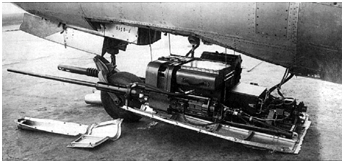
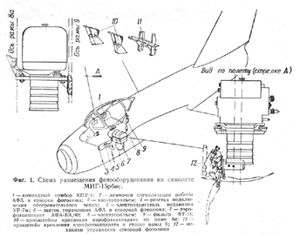 The aircraft also underwent other modifications to eliminate defects found on the MiG-15 such as fogging or frost; a chemical filter was fitted to treat stale air in the cockpit and the pressurization system was improved among other things. However, the tests conducted between August and September revealed many shortcomings such as insufficient photographic coverage, the absence of pivots on the camera (although this was not requested), and a malfunction of the air conditioning system. The aircraft nevertheless retained its performance and combat capabilities and was able to carry out tactical reconnaissance flights. In order to increase the range, new D4-50 hardpoints were fitted in the wings to carry drop tanks with an increased capacity of 600 liters fixed flush under the wings.
The aircraft also underwent other modifications to eliminate defects found on the MiG-15 such as fogging or frost; a chemical filter was fitted to treat stale air in the cockpit and the pressurization system was improved among other things. However, the tests conducted between August and September revealed many shortcomings such as insufficient photographic coverage, the absence of pivots on the camera (although this was not requested), and a malfunction of the air conditioning system. The aircraft nevertheless retained its performance and combat capabilities and was able to carry out tactical reconnaissance flights. In order to increase the range, new D4-50 hardpoints were fitted in the wings to carry drop tanks with an increased capacity of 600 liters fixed flush under the wings.
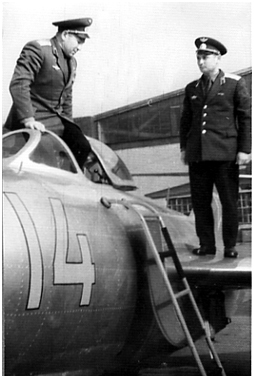 Alexei Leonov de retour à Altenburg en 1965 après son vol historique du 18 mars 1965 dans l'espace, descend du MiG-15Rbis "14" bleu. © L.Borisova.
Alexei Leonov de retour à Altenburg en 1965 après son vol historique du 18 mars 1965 dans l'espace, descend du MiG-15Rbis "14" bleu. © L.Borisova.
Alexei Leonov returned to Altenburg in 1965 after his historic space flight of March 18, 1965. Here aboard MiG-15Rbis blue 14. © L.Borisova.
In August 1951, the Council of Ministers recognized that the need for new reconnaissance capabilities could not be ignored and the SR was accepted into service under the designation MiG-15Rbis (1) (Article 55), of which 364 were built at Gorky Factory n°21 at the same time as the MiG-15bis. The MiG-15Rbis could cover an area between 900 meters and 4.5 km wide over a distance of 90 to 450 km at an altitude of 2,000 to 10,000 meters. The MiG-15Rbis were limited to short-range daytime reconnaissance, while the Il-28R had a longer reach by day and by night.
The first jet reconnaissance aircraft based in the GDR were the MiG-15Rbis of the 294.ORAP.
This regiment did not experience the Second World War, but was activated in March 1951 in Strausberg in the GDR. Its first operational base was Köthen where it was established in November 1951.
The 294.ORAP would then undergo various mutations: Welzow in 1953, Köthen again in 1954, Altenburg in 1955 and finally Allstedt in 1967 - see the order of battle.
It was while the regiment was based in Altenburg that the future cosmonaut Alexei Leonov, who became the first man to "walk" in space on March 18, 1965, was assigned there in December 1959 (> Link 1 /
> Link 2).
While the 294.ORAP retired its last MiG-15Rbis from service in 1968, the two-seater UTI MiG-15 with which it was also equipped remained active until 1974. The first MiG-21R joined the regiment from November 1966.
| ORBAT 1945 - 1993 |
Fishbeds
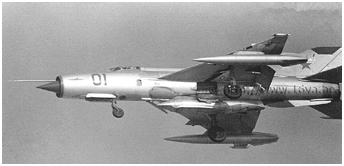 The MiG-21R "Fishbed-H" therefore succeeded the MiG-15Rbis within the 294.ORAP, which represented a major upheaval, both in terms of the aircraft itself and the reconnaissance means it was capable of carrying. The prototype of the MiG-21R, built like the MiG-15Rbis at the Gorky plant, was based on a MiG-21PF "Fishbed-D" interceptor airframe. The R-11F2-300 reactor of 3950 kgp dry (6120 with AB) was replaced by a R-11F2S-300 model with the capability to blow air above the flaps in order to further increase the lift when the latter were extended. Externally, the prototype resembled a MiG-21PFS with its short-chord vertical stabilizer and the braking parachute relocated to the base of the stabilizer. However, small cigar-shaped fairings housing the antennas of a SPO-3 "Sirena" radar warning receiver were mounted on the wingtips. It was inended that different reconnaissance containers could be mounted alternately under the ventral hardpoint. In order to compensate for the unavailability of the latter, which was the only one on which an additional fuel tank could be attached, two new "wet" hardpoints capable of receiving 490-liter PTB-490 drop tanks were added outboard the two existing wing pylons. The centrally mounted PVD-7 pitot tube above the engine air intake, which obstructed the pilot's downward view, was moved to the right. The first flight of the Ye-7R, as it was designated, took place in 1964.
The MiG-21R "Fishbed-H" therefore succeeded the MiG-15Rbis within the 294.ORAP, which represented a major upheaval, both in terms of the aircraft itself and the reconnaissance means it was capable of carrying. The prototype of the MiG-21R, built like the MiG-15Rbis at the Gorky plant, was based on a MiG-21PF "Fishbed-D" interceptor airframe. The R-11F2-300 reactor of 3950 kgp dry (6120 with AB) was replaced by a R-11F2S-300 model with the capability to blow air above the flaps in order to further increase the lift when the latter were extended. Externally, the prototype resembled a MiG-21PFS with its short-chord vertical stabilizer and the braking parachute relocated to the base of the stabilizer. However, small cigar-shaped fairings housing the antennas of a SPO-3 "Sirena" radar warning receiver were mounted on the wingtips. It was inended that different reconnaissance containers could be mounted alternately under the ventral hardpoint. In order to compensate for the unavailability of the latter, which was the only one on which an additional fuel tank could be attached, two new "wet" hardpoints capable of receiving 490-liter PTB-490 drop tanks were added outboard the two existing wing pylons. The centrally mounted PVD-7 pitot tube above the engine air intake, which obstructed the pilot's downward view, was moved to the right. The first flight of the Ye-7R, as it was designated, took place in 1964.
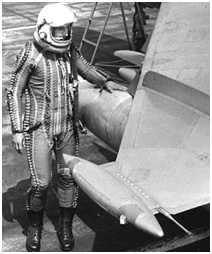 Détail du carénage d'antennes du système SPO-3 sur un MiG-21R polonais. Cet avion était apparemment armé avec des missiles RS-2US accrochés sous les pylônes internes. © DR.
Détail du carénage d'antennes du système SPO-3 sur un MiG-21R polonais. Cet avion était apparemment armé avec des missiles RS-2US accrochés sous les pylônes internes. © DR.
Close up on the antenna fairing of the SPO-3 system on a Polish AF MiG-21R. This aircraft was apparently armed with RS-2US missiles under the
inboard pylons. © DR.
Two further prototypes were converted from MiG-21PFS airframes. These were more MiG-21PFM in appearance with their wide chord tail fin and the cockpit opening laterally rather than tilting forward.
Flight tests highlighted the aircraft's lack of range despite carrying two drop tanks. To address this problem, the fuselage spine was widened and extended to the tail fin to accommodate a 340 liter fuel tank, bringing the total internal capacity to 2800 liters. A mysterious dielectric panel, possibly housing the VHF transmitter antenna that allowed the pilot to transmit information directly by radio over long distances, was located on this spine some distance before the vertical stabilizer. The MiG-21R was also the first model of the "Fishbed" equipped with an angle of attack indicator whose DUA-3 probe was actuated by a valve mounted on the left side of the nose, a feature that would later be found on all subsequent versions of the single-seat MiG-21 and the two-seat MiG-21UM.
Production of the MiG-21R (Article 94R and then O3) began in 1965 and continued until 1971.
The MiG-21R used various five-meter-long reconnaissance containers to carry out its mission. Those commonly carried were the following three models:
 - "D" model (Dnevnaya fotorazvedka - daytime photo reconnaissance). This container had a marked recess under its nose to allow forward photography.
It carried seven cameras, including six A-39 (> Link). A pair of the latter was housed behind
the front recess to cover the sector below the plane's flight axis.
The other four A-39 were located at the rear of the nacelle, also arranged in pairs, one covering the left sector and the other the right sector.
The seventh camera of the AShchAFA-5M type (> Link) designed to cover
strips of terrain (see the two rectangular holes in the photo above) was placed just behind the two forward-pointing A-39 cameras.
The area covered by the vertical cameras was 0.7 times the flight altitude, and twice that for the oblique cameras.
The SPO-3 complex, whose antennas were housed in the fairings at the wingtips, a magnetic tape recorder
Lira and an ASO-2I flare launcher system with two KDS-19 cassettes, each of which capable of firing 32 thermic or electromagnetic (chaff) flares, were located in the rear section of the nacelle.
- "D" model (Dnevnaya fotorazvedka - daytime photo reconnaissance). This container had a marked recess under its nose to allow forward photography.
It carried seven cameras, including six A-39 (> Link). A pair of the latter was housed behind
the front recess to cover the sector below the plane's flight axis.
The other four A-39 were located at the rear of the nacelle, also arranged in pairs, one covering the left sector and the other the right sector.
The seventh camera of the AShchAFA-5M type (> Link) designed to cover
strips of terrain (see the two rectangular holes in the photo above) was placed just behind the two forward-pointing A-39 cameras.
The area covered by the vertical cameras was 0.7 times the flight altitude, and twice that for the oblique cameras.
The SPO-3 complex, whose antennas were housed in the fairings at the wingtips, a magnetic tape recorder
Lira and an ASO-2I flare launcher system with two KDS-19 cassettes, each of which capable of firing 32 thermic or electromagnetic (chaff) flares, were located in the rear section of the nacelle.
 - "N" model (Nochnaya fotorazvedka - night photo reconnaissance). This version dedicated to night reconnaissance carried a UA-47 camera
(> Link) with two lenses inclined 160° to the left and right.
Night photography was made possible by four KDF-38 cassettes containing a total of 152 FP-100 illumination flares, which occupied the space of almost a third of the nacelle.
An ASO-2I flare launcher system was located in the tail section. The "N" pod also included the Lira recorder and the SPO-3 complex.
- "N" model (Nochnaya fotorazvedka - night photo reconnaissance). This version dedicated to night reconnaissance carried a UA-47 camera
(> Link) with two lenses inclined 160° to the left and right.
Night photography was made possible by four KDF-38 cassettes containing a total of 152 FP-100 illumination flares, which occupied the space of almost a third of the nacelle.
An ASO-2I flare launcher system was located in the tail section. The "N" pod also included the Lira recorder and the SPO-3 complex.
 - "R" model (Radiotekhnicheskaya razvedka - electronic reconnaissance). This container was easily recognizable by the large dielectric panels
of the SIGINT systems SRS-6 Romb-4A and SRS-7 Romb-4B (Rhombus) that adorned its sides. The electromagnetic signals captured by this radar detection/classification/location suite were recorded on magnetic wire. An A-39 camera remained mounted in the front, while an ASO-2I flare launcher system and an SPO-3 complex were located in the tail section.
- "R" model (Radiotekhnicheskaya razvedka - electronic reconnaissance). This container was easily recognizable by the large dielectric panels
of the SIGINT systems SRS-6 Romb-4A and SRS-7 Romb-4B (Rhombus) that adorned its sides. The electromagnetic signals captured by this radar detection/classification/location suite were recorded on magnetic wire. An A-39 camera remained mounted in the front, while an ASO-2I flare launcher system and an SPO-3 complex were located in the tail section.
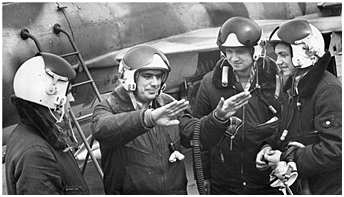 Des pilotes du 294.ORAP discutent le coup devant un MiG-21R camouflé porteur d'une nacelle de reconnaissance. © DR.
Des pilotes du 294.ORAP discutent le coup devant un MiG-21R camouflé porteur d'une nacelle de reconnaissance. © DR.
294.ORAP pilots discussing tactics in front of a camouflaged MiG-21R equipped with a reconnaissance pod. © DR.
Other container models were reportedly used by the MiG-21R, but not necessarily within the 294.ORAP.
The "T" model (Televizionniy Aviatsionniy Razvedyvatel'niy Komplex or TARK - television aerial reconnaissance complex) transmitted real-time images to a ground station using the Bariy (Barium) system. Another pod reportedly carried a Shpil' (Spire) day and night laser reconnaissance system with a data link liaison. A third container was equipped with a Prostor (Space) thermal imaging system. In addition, the MiG-21R was likely to carry an RR8311-100 pod (> Photo) designed to measure the level of radioactivity in the ambient air.
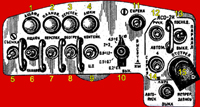 The pilot used a control box fixed under the upper arch of the windshield (click on the drawing on the right), to control the various reconnaissance systems, the flare launchers or the radar warning receiver.
There were at least three versions of control box for the D, N and R containers. Thus, a good part of the aircraft always flew with the same type of container,
in line with the control box mounted on the aircraft.
The pilot used a control box fixed under the upper arch of the windshield (click on the drawing on the right), to control the various reconnaissance systems, the flare launchers or the radar warning receiver.
There were at least three versions of control box for the D, N and R containers. Thus, a good part of the aircraft always flew with the same type of container,
in line with the control box mounted on the aircraft.
The MiG-21R retained air-to-ground capabilities, being able to carry conventional UB-16-57UMP or UB-32 rocket launcher pods, 50 to 250 kg bombs, or S-24 rockets under the inboard hardpoints.
It could perform interception missions when armed with a pair of RS-2-US type IR-guided missiles also mounted under the inboard hardpoints. R-3S missiles could be placed under the inboard or outboard hardpoints. Sometimes, the antenna fairings of the SPO-3 were removed for these missions because they were unecessary, since the system's electronics were housed in the reconnaissance pods. The RP-21M radar of the MiG-21PFM was mounted in the nose.
Two-seater versions of the MiG-21 of course flew within the 294.ORAP, from the early MiG-21U model to the latest MiG-21UM version.
Fitters
 In 1978, the 294.ORAP became the first of the twelve VVS units to receive the reconnaissance version of the Strij (Swallow) as the Su-17 were nicknamed (see section "3.3 Ground-Attack Aviation and Fighter-Bombers" for more information about the different versions of the Su-17 > Link).
These were Su-17M3 "Fitter-H" which coexisted for a time with the MiG-21R in two different squadrons - the third squadron was disbanded. In August 1981, the second squadron was in turn completely re-equipped with new Su-17M3 of the 64th series. In total, 30 aircraft equipped the regiment, namely 24 single-seater Su-17M3 and 6 two-seater Su-17UM3 in the mid-1980s.
In 1978, the 294.ORAP became the first of the twelve VVS units to receive the reconnaissance version of the Strij (Swallow) as the Su-17 were nicknamed (see section "3.3 Ground-Attack Aviation and Fighter-Bombers" for more information about the different versions of the Su-17 > Link).
These were Su-17M3 "Fitter-H" which coexisted for a time with the MiG-21R in two different squadrons - the third squadron was disbanded. In August 1981, the second squadron was in turn completely re-equipped with new Su-17M3 of the 64th series. In total, 30 aircraft equipped the regiment, namely 24 single-seater Su-17M3 and 6 two-seater Su-17UM3 in the mid-1980s.
A note should be made concerning the designations of the reconnaissance versions of the Su-17M3 and M4. While there was a manufacturer designation for the M4 recce version, namely S-54R, this was not the case for the Su-17M3, which remained S-52 in all cases. We can also see on the table above that the single-seaters were simply designated S-52 and the two-seaters S-52UM3. The Su-17M3 built from the 54th series onwards bore the designation S-52P and, like the Su-17M4, were capable, in addition to ordinary ground attack missions, of carrying out two specific missions. They were either reconnaissance with carrying specialized pods, or anti-radar missions (V'youga container, Kh-25MP, Kh-27PS and Kh-58U missiles). In practice, the aircraft of a unit dedicated to reconnaissance such as the 294.ORAP quite logically kept a fixed configuration. We will nevertheless designate the reconnaissance versions by the letter R at the end in order to avoid confusion.
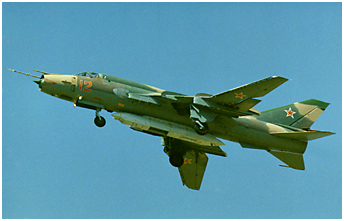
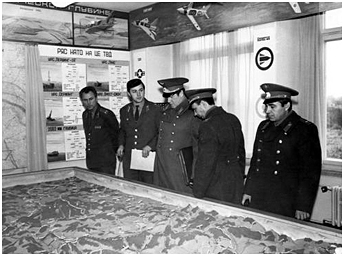 Visite officielle à Allstedt au cours des années 80. On distingue au mur des photos d'équipements de l'OTAN ainsi que des dessins d'avions dont un Lightning et un
Fiat G.91 ainsi que quelques cocardes occidentales. © Collection A.Gordienko.
Visite officielle à Allstedt au cours des années 80. On distingue au mur des photos d'équipements de l'OTAN ainsi que des dessins d'avions dont un Lightning et un
Fiat G.91 ainsi que quelques cocardes occidentales. © Collection A.Gordienko.
Some official visit at Allstedt during the 1980s. Pictures of NATO equipment can be seen in the background, together with aircraft
drawings including a Lightning and a Fiat G.91 and also western cockades. © A.Gordienko Collection.
The Su-17M3R carried various reconnaissance pods specially designed for the Su-17/-20/-22 family, which were attached as standard under the fuselage to the central hardpoint.
Designated "Containers with reconnaissance complex" (KKR - Konteyner Kompleksnoy Razvedki), these massive 7-meters--long pods required additional wiring to the carrier aircraft in order to control the reconnaissance systems via two dedicated consoles mounted in the cockpit.
The pods carried by the Su-17M3R were of two different models, designated KKR-1 and KKR-1/2. These modular pods included a section with cameras and a compartment
where the other reconnaissance assets were housed.
 - The KKR-1 model was equipped with an A-39 camera in the front (it was set to a vertical or oblique position up to 55° before the flight). It was used at low or medium altitudes up to 5000 meters. Next came a PA-1 panoramic camera equipped with rotating prisms for photographing strips of terrain to the left and right of the aircraft. The length of the photographed strip corresponded to ten times the flight altitude. Finally, a UA-47 camera
(> Link) with two lenses was intended for night photography. For this purpose, it was paired with four KDF-38 cassettes containing FP-100 illumination flares. These cassettes were mounted only when needed, otherwise their slots remained empty as can be seen in some of the photos illustrating this article or in the associated photo gallery. Panoramic and night photographs were not taken above 1200 meters altitude. The aft part initially housed a SIGINT SRS-9 Viraj system, later replaced by the SRS-13 Tangaj, whose dielectric panels were visible on the rear sides of the nacelles. The SRS-13 suite was intended for radar localization, classification and frequency identification. Thus equipped with the SRS-13, the container took the designation KKR-1T (for more information on this container, visit this > Link /
video detailing a KKR-1T from the LSK/LV > Link).
- The KKR-1 model was equipped with an A-39 camera in the front (it was set to a vertical or oblique position up to 55° before the flight). It was used at low or medium altitudes up to 5000 meters. Next came a PA-1 panoramic camera equipped with rotating prisms for photographing strips of terrain to the left and right of the aircraft. The length of the photographed strip corresponded to ten times the flight altitude. Finally, a UA-47 camera
(> Link) with two lenses was intended for night photography. For this purpose, it was paired with four KDF-38 cassettes containing FP-100 illumination flares. These cassettes were mounted only when needed, otherwise their slots remained empty as can be seen in some of the photos illustrating this article or in the associated photo gallery. Panoramic and night photographs were not taken above 1200 meters altitude. The aft part initially housed a SIGINT SRS-9 Viraj system, later replaced by the SRS-13 Tangaj, whose dielectric panels were visible on the rear sides of the nacelles. The SRS-13 suite was intended for radar localization, classification and frequency identification. Thus equipped with the SRS-13, the container took the designation KKR-1T (for more information on this container, visit this > Link /
video detailing a KKR-1T from the LSK/LV > Link).
 - The KKR-1/2 model retained the same cameras, but the aft part this time housed module n°2, which included an 8R Zima (Winter) thermal imaging complex and a 429T Chibis-B (Lapwing) television reconnaissance station. The TV and IR images were relayed to a ground station via a Trassa data link suite, the antennas of which were visible under the container. Module n°3, mounted in place of n°2, included a SRS-13 Tangaj SIGINT suite and a Shpil'-2M laser reconnaissance unit. In the latter case, the container designation became KKR-1T/2.
- The KKR-1/2 model retained the same cameras, but the aft part this time housed module n°2, which included an 8R Zima (Winter) thermal imaging complex and a 429T Chibis-B (Lapwing) television reconnaissance station. The TV and IR images were relayed to a ground station via a Trassa data link suite, the antennas of which were visible under the container. Module n°3, mounted in place of n°2, included a SRS-13 Tangaj SIGINT suite and a Shpil'-2M laser reconnaissance unit. In the latter case, the container designation became KKR-1T/2.
There was also a KKR-1M pod equipped with an AFA-42/100 camera (> Link) as well as Chibis-B and Zima systems. The AFA-42/100 camera with a focal length of 1000 mm, also used by the Long-Range Aviation on board the Tu-16R and Tu-22R, was specifically designed for long-range oblique photography from high altitudes.
The Su-17M4R used KKR-2A containers (cameras A-39 and AP-402, Aist-M TV and Zima IR systems), KKR-2T (SRS-13 Tangaj), KKR-2Sh (SLAR Shtik-2M), KKR-2P (Shpil'-2M) and KKR-2E (Efir-1M) - for the Aist-M, Shtik-2M and Efir-1M see > the 11.ORAP.
Many of the reconnaissance systems carried on board the Su-17M3R and M4R pods were later integrated into the Su-24MR. The 8R Zima infrared complex recorded thermal images on film and quite logically allowed night reconnaissance. A rectangular fairing oriented in the direction of flight located under the container betrayed its presence. The TARK 429T Chibis-B reconnaissance system mounted in front of it ensured the transmission of live images to a ground station mounted on a truck. However, a lower quality image was the price to pay. The Shpil'-2M laser worked with an illuminator and a photodetector. The images recorded on film were of better resolution than thermal images, but close to those on television. The illuminator function was not necessary during the day.
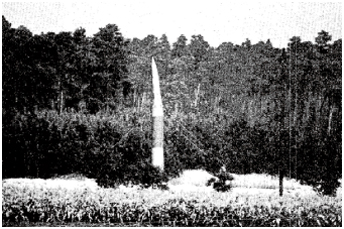 "Le 15 août [1973], une zone d'exercice temporaire fut déployée et installée près de la ville de
Soellichau. Deux maquettes gonflables de missiles PERSHING, deux maquettes de batteries de missiles HAWK et une
station radio de type R-821 y furent observés. Quatre MANGROVE [Yak-27R] de Werneuchen ainsi que trois
FISHBED H [MiG-21R] d'Allstedt furent observés au-dessus de la zone au cours probablement d'un exercice ou d'une
compétition pour appareils de reconnaissane." © USMLM.
"Le 15 août [1973], une zone d'exercice temporaire fut déployée et installée près de la ville de
Soellichau. Deux maquettes gonflables de missiles PERSHING, deux maquettes de batteries de missiles HAWK et une
station radio de type R-821 y furent observés. Quatre MANGROVE [Yak-27R] de Werneuchen ainsi que trois
FISHBED H [MiG-21R] d'Allstedt furent observés au-dessus de la zone au cours probablement d'un exercice ou d'une
compétition pour appareils de reconnaissane." © USMLM.
"On 15 August [1973], a probable mobile range was deployed and set up near the town of Soellichau.
Observed at the range were two inflatable PERSHING missile mock-ups, two HAWK missile battery mock-ups, and
an R-821 ground to air radio. Four Werneuchen-based MANGROVE [Yak-27R] and three Allstedt FISHBED H [MiG-21R] were observed
conducting reconnaissance flights over the range area during a probable exercise/competition for
reconnaissance aircraft." © USMLM.
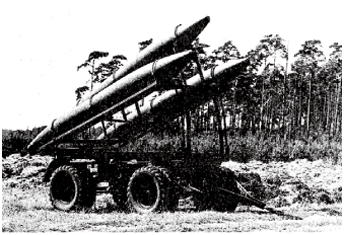 A training ground of the 8th Guards Combined Arms Army located northwest of Naumburg was regularly
used during routine training missions, when ground personnel and probably a mobile data collection station were deployed there
(Google Earth file showing the routes usually followed by the aircraft of the 294.ORAP to download > Here -
created by M.Bischoff).
Targets were approached at low altitude before climbing to the working altitude at the appropriate time. At night, flare bombs were dropped during the climb and the aircraft then descended in order to photograph under the glow of the flares. The Su-17M3R and M4R retained all their offensive and defensive capabilities (the Su-17M3R often carried an SPS-141[142/143]MVG Gvozdika electronic countermeasures pod under the left inner pylon).
That was a significant improvement over the MiG-21R, which was limited to carrying bombs and rockets under two pylons.
The Combat Training Course of the Reconnaissance Aviation had almost the same specifics as the fighter-bomber course, and the 294.ORAP regularly used the Belgern firing range.
In addition, if an aircraft on an armed reconnaissance mission spotted a particularly important target such as nuclear missiles, the pilot was instructed to launch an attack without delay.
Numerous shooting exercises were carried out each year in addition to the specific reconnaissance tasks which required mastery of photographic and visual reconnaissance, as well as the management of SIGINT, IR and TV systems.
A training ground of the 8th Guards Combined Arms Army located northwest of Naumburg was regularly
used during routine training missions, when ground personnel and probably a mobile data collection station were deployed there
(Google Earth file showing the routes usually followed by the aircraft of the 294.ORAP to download > Here -
created by M.Bischoff).
Targets were approached at low altitude before climbing to the working altitude at the appropriate time. At night, flare bombs were dropped during the climb and the aircraft then descended in order to photograph under the glow of the flares. The Su-17M3R and M4R retained all their offensive and defensive capabilities (the Su-17M3R often carried an SPS-141[142/143]MVG Gvozdika electronic countermeasures pod under the left inner pylon).
That was a significant improvement over the MiG-21R, which was limited to carrying bombs and rockets under two pylons.
The Combat Training Course of the Reconnaissance Aviation had almost the same specifics as the fighter-bomber course, and the 294.ORAP regularly used the Belgern firing range.
In addition, if an aircraft on an armed reconnaissance mission spotted a particularly important target such as nuclear missiles, the pilot was instructed to launch an attack without delay.
Numerous shooting exercises were carried out each year in addition to the specific reconnaissance tasks which required mastery of photographic and visual reconnaissance, as well as the management of SIGINT, IR and TV systems.
The 294.ORAP did not survive German reunification for very long, even earning the title of the first regiment of the 16.VA to evacuate the territory of the former GDR on the occasion of its final withdrawal in the spring of 1991. However, it should be mentioned that, unlike other departures of units of the 16.VA observed at the same time, the departure of the 294.ORAP did not take place within the framework of of the negotiated general withdrawal of Soviet forces from Germany, but by virtue of the so-called CFE (Conventional Forces in Europe) agreements, relating to the reduction of conventional forces in Europe (2). On 21 May, the regiment definitively left Allstedt for Jekabpils in Latvia where the 886.ORAP equipped with Su-17M4R was stationed. But, still to remain in compliance with the CFE agreements, a squadron of the 294.ORAP was quickly transferred to Domna in the Transbaikalia district, where its Su-17M3R became a squadron of the local 125.ORAP aligning two other squadrons equipped with Su-24MR. These Su-17M3R were withdrawn from service in 1995 and to the storage base of Step'. The equipment and personnel of the other squadron of the 294.ORAP were distributed between Transcaucasia in Vaziani in order to reinforce the 313.ORAP then equipped with Su-17M4R and Uzbekistan at Karshi-Khanabad where the 87.ORAP was based with Su-17M3R.
 |
Politics, Reconnaissance and Women |  |
 |
MiG-21R PHOTO PAGE |  |
 |
Su-17M3R PHOTO PAGE |  |
notes
(1)
There are several interpretations of the designation of the MiG-15bis reconnaissance aircraft: MiG-15bisR, MiG-15R-bis and MiG-15Rbis. We will
stick to the latter designation, since it is the one that appears on the technical document at the top of this page.
(2)
The CFE agreements were signed on November 19, 1990 in Paris, on the occasion of the Conference on Security and Cooperation in Europe
(CSCE, now an organisation abbreviated to OSCE), by 22 countries of the Atlantic Alliance and the Warsaw Pact.
 |
Plan du site - Sitemap |  |
